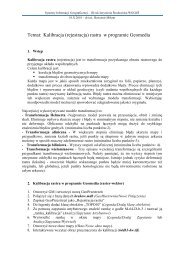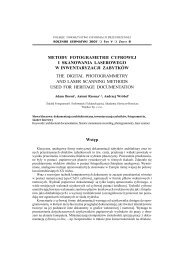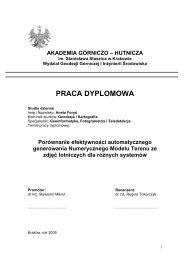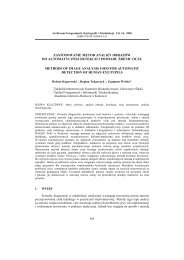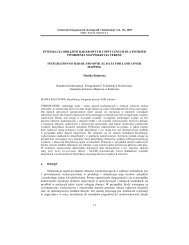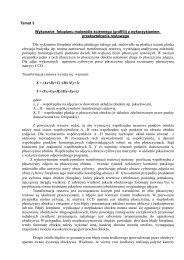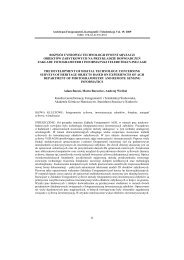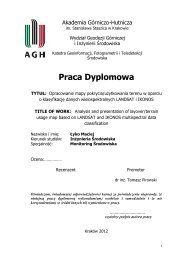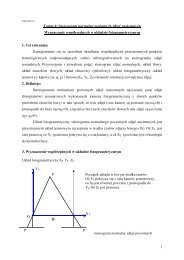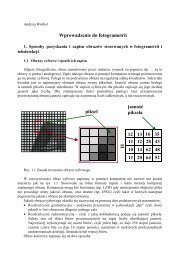Praca Dyplomowa - Photogrammetry and Remote Sensing - AGH
Praca Dyplomowa - Photogrammetry and Remote Sensing - AGH
Praca Dyplomowa - Photogrammetry and Remote Sensing - AGH
Create successful ePaper yourself
Turn your PDF publications into a flip-book with our unique Google optimized e-Paper software.
SUMMARY<br />
Sculptures <strong>and</strong> other artifacts are exposed to damages <strong>and</strong> it is hard to avoid them. For<br />
cultural heritage preservation new replicas of these objects should be done. For this purpose<br />
the best solution is to use non-touching methods, like photogrammetry <strong>and</strong> three-dimensional<br />
scanning, which will not do any harm to the object. Then 3D digital model may be used <strong>and</strong><br />
by applying of 3D printers the real copy may be done<br />
The purpose of the report was to investigate methods on making detailed digital models on<br />
example of a sculpture from Nidaros Cathedral. The goal was to get as accurate – detailed<br />
model as possible. There is comparison on photogrammetric, 3D scanning methods <strong>and</strong><br />
available 3D modelling tools.<br />
To make a very detailed digital model of round, complex, <strong>and</strong> small objects – very big point<br />
cloud is needed. The point cloud has to be accurate with high resolution. To make such a<br />
point cloud from images any software needs a lot of time for computation. Also, computation<br />
of big amount of points in the data from scanning takes a lot of time. This is not because of<br />
low PC, but because of software limitations. Some scanners are able to make more dense<br />
point cloud with better accuracy than others. With higher resolution <strong>and</strong> better accuracy<br />
scanners become smaller, <strong>and</strong> also distance range is decreasing. Though, for small object<br />
smaller distance is required. <strong>Photogrammetry</strong> may produce also very good results, if only the<br />
material is non-reflective/shiny, or glass.<br />
In the project photogrammetric software has been used, such as PhotoModeler Scanner <strong>and</strong><br />
Topcon ImageMaster, where both are able to create 3D surface from photographs, taken by<br />
non-metric camera. Both softwares provide camera calibration. The results at the end were<br />
quite good, but the sculpture is quite shiny <strong>and</strong> reflects the light, <strong>and</strong> this situation is not<br />
required for image matching <strong>and</strong> creating 3D points. Therefore, the model results with a lot of<br />
noise. Also, the time needed for DSM creating was very long <strong>and</strong> this part still needs some<br />
improvement. Free software from Autodesk – Project Photofly 2.0 was also tested. The<br />
application creates mesh <strong>and</strong> may be used by non-experienced users. Nevertheless, the results<br />
are not so accurate or the resolution is lower, it still may be used in most common situations.<br />
From laser scanning, Konica Minolta VI-910 was used for data acquisition, but also very<br />
interesting h<strong>and</strong>held small scanner from Artec was used. Both are created for small range<br />
distances; nevertheless Artec seems to be better for smaller objects. It has better accuracy <strong>and</strong><br />
higher resolution. In both cases, softwares recommended by the companies were used for<br />
modelling. Geomagic software was also used for post processing afterwards. Polygon Editing<br />
Tool from Konica Minolta seemed not working properly with new Windows 7 x64 bits, but<br />
Artec was even able to use most of the processors cores for computations.<br />
The best model was achieved by applying small structured scanner from Artec with 0,5mm of<br />
resolution <strong>and</strong> accuracy up to 0,1mm. The model created using Artec software works good,<br />
but in the author‟s opinion Geomagic software works better, where smoothing may be done in<br />
the respect to curves.<br />
vi




